Expert tips on breeding snakes of the genus Lampropeltis.
A kingsnake is a member of any one of eight species and multiple subspecies that make up the genus Lampropeltis. The eight species include the gray-banded kingsnake (alterna), prairie kingsnake (calligaster), common kingsnake (getula), Mexican gray-banded kingsnake (mexicana), Sonoran mountain kingsnake (pyromelana), Ruthven’s kingsnake (ruthveni), California mountain kingsnake (zonata) and milk snake (triangulum). (Milk snakes are also kingsnakes; they are the only one of the eight species that doesn’t have the word “kingsnake” as part of their common name, but oddly one of the subspecies of the milk snake group is the scarlet kingsnake.)
Kingsnakes have the largest natural geographical range of any land snake, being found from southern Canada to northern South America, from below sea level to more than a mile high in elevation and from jungle to desert habitats. Kingsnakes are powerful constrictors that feed on almost any animal they can overpower and swallow whole, including venomous snakes. They range in size from 18 inches to almost 8 feet.
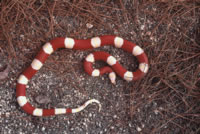
Bob Applegate
A kingsnake is a member of any one of eight species and multiple subspecies that make up the genus Lampropeltis. .
Most kingsnakes make good pets. Many are very colorful, and some are coral snake mimics. Most are easy to care for in captivity. This article will concentrate on breeding this wonderful group of snakes in captivity.
Choices, Choices, Choices
Which kingsnake should you select? Some, like the scarlet kingsnake, are extremely colorful and do very well when their captive requirements are met; however, their hatchlings are so small that it is difficult to find appropriate-sized food. Some, such as the gray-banded kingsnake, do great as adults, but many of the neonates require lizards or tricks to get them to start feeding. Others, such as the larger milk snakes and common kingsnakes, can exceed 6-foot lengths.
All the kingsnakes deserve to be worked with. But my advice includes doing your homework, visiting breeders if possible, making sure you have the resources necessary to care for the snake and then make your choice. Once you have made a decision, check availability, talk to breeders who produce your selection and ask last-minute questions before making a purchase. It’s best to purchase captive-bred kingsnakes. Except in rare circumstances, it makes no sense to collect or buy wild-caught kingsnakes for a breeding colony when there are so many beautiful, parasite-free, captive-produced kings that readily feed available.
I suggest buying baby kingsnakes that have fed at least three times on baby mice before you take possession. You can assume that the parents were healthy and well kept, or the babies wouldn’t be available for sale.
Purchasing adult snakes scares me. I don’t want to tell you how many adult snakes have been offered to the general public as “proven breeders” (not by me!). Many I’ve seen were proven alright — proven to be sterile or laying infertile eggs. There are probably cases where young healthy breeder snakes are offered, but again, ask questions. One question should be: “Why are you selling a pair in prime condition for this price when you can make more each year selling the offspring?”
Inbreeding
If you buy related snakes for your breeders, is that bad? As with most questions relating to reptiles, there is no absolute answer. Inbreeding is common in herpetoculture. If it is done and the results are good, that’s called line breeding. If the results are bad, it is “inbreeding syndrome.” Wild snakes in general don’t travel far, and many return to one area for breeding each spring. Many wild populations have inbreeding.
Many kingsnakes have been bred brother to sister for many generations in captivity with no noticeable negative effects. If there are no “bad genes” present, the resulting offspring will be OK; results of normal-phase breeding seem to bear that out.
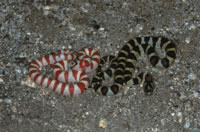
Bob Applegate
Doing homework before purchasing a kingsnake is important.
With genetic mutations, such as albinism, something malfunctioned in the animal’s genetic makeup to lose the normal coloration or characteristic. There is a much greater chance that there could be other faulty genes present. Bottom line: If unrelated snakes are available, these are preferable. If you can only get your hands on related breeders, however, it should be OK.
Breeding Groups
For a basic breeding group, I recommend purchasing two male kingsnakes and four female kingsnakes, as unrelated as possible (unless there is a certain genetic trait you want to isolate and work with, in that case, related works best). If all grow to maturity, you have two trios; when it comes time to sell or pick for future generations of breeders, you can mix from the two unrelated trios. If something happens to one male, your second male can breed to all four females, and if one female “goes down,” you still are in production.
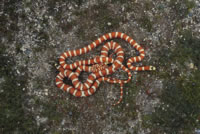
Bob Applegate
Type image description here.
Be sure the kingsnakes are sexed correctly. Check for yourself, or have the breeder confirm the sex and show you how. The usual mistake is to think a male is a female because the hemipenes don’t “pop” when checked. I always double check with a probe. You don’t want to raise your snakes for two to three years only to find out some of your girls are boys.
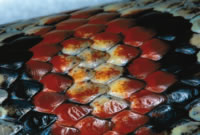
Bob Applegate
The bright color patterns on kingsnakes are part of the large attraction to them.
Raising Youngsters
I prefer a clear, plastic shoebox rack system to raise my baby kingsnakes. I usually keep babies in the standard shoebox during the first year. The cage floor has heat provided by heat tape toward the rear (with the thermostat set at 84 degrees Fahrenheit and a background temperature in the mid-70s), so the snake can thermoregulate.
Each shoebox has a snake record card taped on the lid. I prefer fine, kiln-dried pine shavings as substrate and provide a lightweight water bowl for each baby. (If you use a heavy water bowl, make sure it’s resting on the cage floor; if there is substrate underneath, it may attempt to burrow and crush itself.) Keep neonate kingsnakes separately. If you keep baby kings together, one may kill and swallow its cagemate, often dying itself in the process.
I don’t believe you can overfeed the baby kingsnakes at this point; offer two, three, even four meals a week. Make sure to use size-appropriate rodents. Each meal should leave a small but noticeable lump in the snake’s body.
If your kingsnakes accept and keep their meals down, they will grow rapidly. Size is the important thing in sexual maturity, not age. I have had Pueblan milks breed at 9 months and Durango mountain kings double clutch before their second birthday. Not all snakes accept food and grow this fast, but as long as they are getting long — not fat — it’s fine. Once they near their adult size (which varies with species and individuals) and start getting fat, slow down on the food. You do not want overweight breeder snakes.
If your kingsnakes accept food all year, feed them through the first winter. If they seem healthy, but refuse food during the winter (many individuals of some of the mountain species do this), brumate them.
The cage should be dry, but with drinking water available. If it gets too humid, consider a covered water bowl, or remove the bowl for a few days. When the ventilation holes in the box can’t keep up with the humidity caused by feces, or you have to clean the box too often, it is time to move the kingsnake up to a sweaterbox, and for smaller species, a breeder cage.
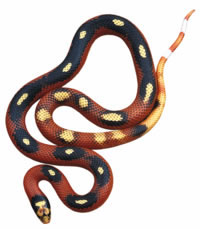
Bob Applegate
The mating process of kingsnakes takes a lot of close attention from the breeders.
Setting the Mood
As your kingsnakes’ second winter approaches, it’s time to evaluate them as potential breeder candidates. Are they large enough to breed next spring? Again, go to your breeder for answers specific to the species with which you’re working. Some kingsnakes breed at less than 31/2 ounces, others should be more than 101/2 ounces.
If you decide to breed your kingsnakes, do not feed them during the last two weeks of October. Keep them warm, so they can digest and pass any remaining stomach contents. Then put the snakes together as a breeding group; limit it to one male per group, but as many females as you can reasonably track.
I keep adult kingsnakes together year-round, though they are separated for feeding and when a female is ready to lay eggs. Always feed kingsnakes in isolation, and keep them apart for a few hours until the feeding response has abated. I have 2-foot-square, glass-fronted cages with multiple drawers underneath that I can use to isolate them. Remember that in the wild these snakes are solitary as well as snake eaters, so watch them for a while after any introduction.
Turn the heat down or off, depending on your background temperatures, and let the cage temperature drop to about 50 degrees Fahrenheit. Some of the more tropical kingsnakes do not need this low of a drop; in the wild they may coordinate their breeding cycle with daylight hours or perhaps the rainy season. However, I have worked with all eight kingsnake species, and this works. The temperatures in the room will fluctuate some, but avoid major changes (10 degrees or more) in a short time, even if you have to insulate the room or cage.
Check on the kingsnakes once a week or so, give them fresh water and keep an eye out for shed problems. If an animal has shedding difficulties, soak it overnight in a shallow ventilated container as you would normally. However, the water should be at the cold-room temperature (in the 50s). The skin should be loose the next day.
My kingsnakes receive a cooling period (brumation) from November 1 to March 1. My cages are large and contain lots of Calci-Sand, so they do not change temperatures quickly. On March 1, I hit a switch, and all the heat tapes come on. It takes a few days for the cages to heat up. Some breeders believe you should gradually bring up the heat a few degrees a day. Either way works.
Time for Action
Think multiple, frequent meals. A male kingsnake may go off feed or never start feeding during the breeding season. If a female refuses her normal food item, try to entice her with a delicacy like a baby rat or a handful of fuzzy mice (even when she’s shedding).
A common mistake is allowing male kingsnakes to get too warm at this time. If they get too warm, they become sterile. There should be a warm area of 80 to 85 degrees Fahrenheit in their cages, but cooler spots as well. In the wild, males can get very warm during the day, but they are subject to much cooler nighttime temperatures. A variable thermostat (such as the Helix Controls I use) programmed for a night drop does this well. If your entire room is warm, put the males in separate cages on the floor.
If a male kingsnake is kept separate from the females, he should be introduced into their cage every three to four days and left for a few hours. Watch for breeding activity. Sometimes kingsnakes mate before the first meal of the season, but usually they mate after the female has her first shed. Some kingsnakes copulate for six to 10 minutes, some for hours. When the male withdraws, there will be a drop of seminal fluid (called the seminal plug) that falls off the hemipene as it inverts.
Checking for Sperm and Follicles
You can check for sperm under a microscope. Take the seminal plug on a mount, add some saline solution if necessary (contact lens solution also works), and put it under a microscope on shaded screen at 200 power. You should see lots of sperm swimming. If you do not, you’ll want to use your second male.
One reason I like the Calci-Sand so much is that I can see the seminal plug on the sand if I miss the actual mating. In that case, I gently squeeze a little fluid from the mated female kingsnake and do a sperm check. I have found a few live sperm up to a week after a confirmed mating, but the sooner you test the better.
Often when a female kingsnake is ready to breed, you can feel her follicles. Gently indent your thumb up into her rib cage about mid-body, and let her crawl over your thumb. You can feel bumps like soft marbles. These develop into eggs if fertilized. It is very important that a male be with her at this time.
Nesting and Incubation
Kingsnakes can retain sperm and become fertilized well after copulation. I have had snakes lay good eggs the following year, without a male being present. Usually 45 to 60 days after copulation, the female sheds. This should be the pre-egg-laying shed. The back third of the female’s body looks distended.
Isolate her from other kingsnakes, and provide a laybox. I like Tupperware-type containers with a hole cut in the top; these are partially filled with slightly moistened sphagnum moss. Good eggs are typically laid in six to 10 days after the shed.
Remove the eggs, and place them in your incubator. Keep them in the same position you found them, and remember the “big three” for incubation: proper temperature (8O to 82 degrees Fahrenheit), proper humidity (close to 100 percent) and good ventilation. Eggs should be dry to the touch, but moisture should show on the side of the incubation chamber. I use vermiculite for incubation, but I have also used perlite with success.
If eggs are infertile or go bad, they may become soft, limp, smelly or sweaty. Don’t throw eggs away until you are certain they are bad. I’ve had some pretty awful-looking eggs hatch. Only throw bad eggs out if they can safely be removed from a good clutch. You don’t want to ruin a good egg that is attached to a bad one.
At this time, evaluate the female again. Is her condition good enough to warrant a second (or third) clutch? Either way, feed her multiple small meals. If you decide she’s OK to breed again, immediately reintroduce the male kingsnake. She may already have a second clutch without the male if she is in good condition, but you get more fertile eggs with a second mating. If the mating is successful, the next shed will be another pre-egg-laying shed. Feed your kingsnakes well the rest of the season, until brumation time.
Your eggs should hatch in 55 to 75 days after laying. If some eggs initially hatch, and two to three days later the rest have not slit, you might consider slitting them yourself.
The newly hatched baby kingsnake should be separated. Keep their individual record cards showing hatch dates, parents, etc. handy. You will want this information for tracking purposes in the future, especially if your snakes end up producing a desirable trait. The neonates usually shed approximately one week later. Once they have shed, they are ready for their first meal. Depending on the snake and the amount of nutrition carried from the egg, some wait almost a month to feed. Now is the time to try to find what they will accept. Good luck!

